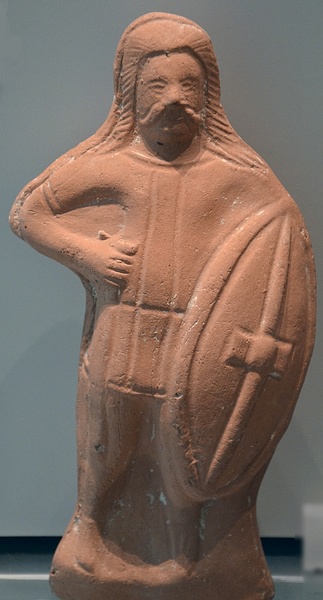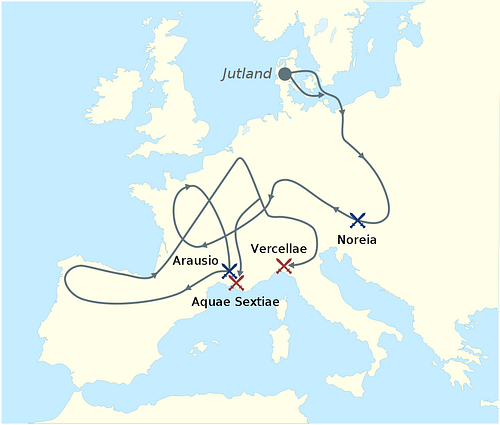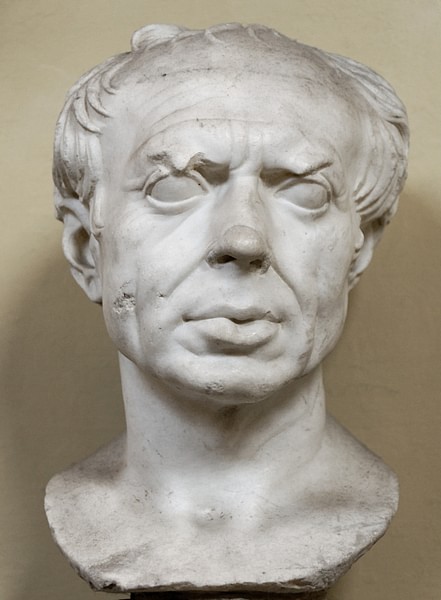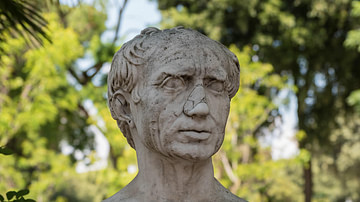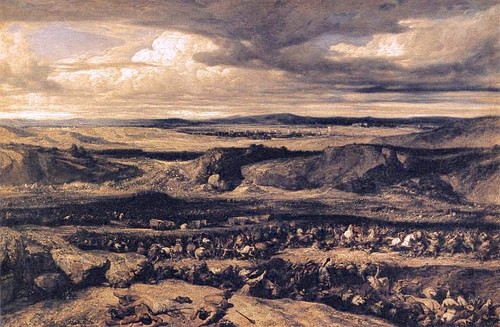
The Cimbri were a tribe who lived in northern Jutland during the Roman era. Their ethnicity is enigmatic; scholars generally believe that the Cimbri were Germans, though others maintain that they were Celts. The late 2nd-century BCE migration of the Cimbri led them to the Balkans, over the Alps, throughout Gaul, along the borders of Spain, and finally into Italy. They were joined by other Germanic and Celtic tribes; most notably the Teutones who were their neighbors in Jutland and shared much of their history. The Cimbri coalition reached the frontiers of the Roman Republic, where they fought and defeated multiple Roman armies. Their victory at Arausio (Orange) in 105 BCE, was one of the greatest disasters in the history of Roman warfare. The Cimbri entered Italy in 102 BCE when under the leadership of Boiorix they crossed the Alps and settled north of the Po. The following year, they were decisively defeated at Vercellae by the Roman commanders Marius and Catulus. Survivors of the battle were enslaved, but fragments of their tribe continued to live for centuries in eastern Gaul and in their Jutland homeland.
Origin
The Cimbri appear in Roman history in 113 BCE. Their homelands were on the western side of the Jutland peninsula, beside those of their close allies, the Teutones. These lands were within the Germanic tribal realm, leading many scholars to believe that the Cimbri and Teutones were Germanic tribes. However, the names of their chiefs were Celtic; leading others to believe that they were Celts. A probable explanation is that the Romans at the time were not familiar with the German tribes and transmitted their names in the more familiar Celtic form. The Cimbri and Teutones also spent many years in Celtic lands before they met the Romans and would have at least picked up a smattering of the Celtic languages. Classical authors themselves are divided in opinion whether the two tribes were Germans or Celts. Tacitus (56-120 CE) and Strabo (63 BCE - 23 CE) described them as German tribes. Appian (c. 95-165 CE), by contrast, clearly distinguished the Cimbri from the Germans, and along with Florus (c. 74-130 CE) considered them to be Celts. Plutarch (46-120 CE) stated that the prevalent opinion was that the Cimbri were Germans, though he added that others thought they were Gallo-Scythians or even the Cimmerians of Greek mythology, who lived at the edge of the world.
Migration
Near the end of the 2nd century BCE, rising sea levels flooded the coastal lands of the Jutland Peninsula. The loss of their lands induced the Cimbri and Teutones to seek fairer realms elsewhere. In an age of superstition, the encroachment of the ocean was likely seen as a sign from the gods. The diminished arable land likely led to local conflicts, providing further impetus for their epic migration through Europe.
Classical historians described the Cimbri and Teutones as overwhelming hordes, with Plutarch claiming they fielded 300,000 warriors. Such numbers were hardly possible, having more to do with the justification of Roman defeats or the magnification of victories. In reality, the limited geographical area of their origin, alongside relatively sparse population density and supply and travel logistics suggests a much smaller number of people. Growing along their way into a Germanic-Celtic tribal coalition, the Cimbri and Teutones at their peak numbered perhaps 150,000 men, women, and children. At the onset, however, there must have been considerably fewer of them. Not all the Cimbri and Teutones had joined the migration, and a portion of them remained behind on the Danish coast.

The Cimbri and Teutones journeyed south along the Elbe, then east along the Danube, through the realms of Germanic tribes. In Bohemia, they entered the Celtic lands of the Boii from whence they struck for the Balkan lands of the Celtic Scordisci. The interactions of the Cimbri and Teutones with local tribes were at times prone to turn violent. Passing through or temporary settling put stress on the resources, subjected locals to raids, evoked counterattacks and could cause a wholescale exodus of fleeing tribes. At other instances, however, contact would have been more peaceful, resulting in trade and even alliances. Bands of warriors, families, and clans set out to join the tribal coalition. Heading westward, the Cimbri and Teutones followed the Drave through the passes of the Carnie Alps. There, in 113 BCE they entered the Celtic Kingdom of Noricum, a close trading partner of the Roman Republic.
Roman Defeats in Gaul
Consul Papirius Carbo was sent to ward off the barbarian menace. The Cimbri wanted no trouble and accepted Carbo's offer to escort them back across the Noricum border. Carbo lured them into an ambush, but the barbarians savagely counterattacked. The Roman army would have been completely annihilated if a sudden storm did not put an end to the battle. Blamed for the disaster, Carbo took his life by poison.
After their victory, the Cimbri and Teutones wandered over the Alps where they were joined by like-minded Celtic Tigurini of western Switzerland. By way of the lowlands between the Jura and Vosges Mountains, the tribal coalition descended into central Gaul. They pillaged the countryside, causing a mass exodus of rural folk to the safety of walled towns. The Cimbri lacked the know-how of siege warfare to breach the Gallic walls. The latter offered no protection against starvation, however. Numerous town folk and refugees succumbed to hunger and the likely outbreaks of pestilence.
In 109 BCE the Cimbri coalition headed into Gallia Narbonensis only to be blocked again by a Roman army, this time commanded by Consul M. Junius Silanus. The tribes sent envoys, asking that “the people of Mars should give them some land by way of pay and use their hands and weapons for any purpose they wished” (Florus, Epitome of Roman History, Book I). Silanus told them that Rome has no lands to give and desired no services. Battle ensued and, like Carbo before him, Silanus went down in defeat. Despite their victory, the Cimbri and Teutones turned back north to continue to plunder Gaul for four more years. During this time, the Tigurini went their own ways, venturing down the Rhine and in 107 BCE defeating yet another Roman army northwest of Tolosa. Two years later, the Cimbri and Teutones reappeared on the borders of Narbonese Gaul.
Arausio (Orange), 105 BCE
In October 105 BCE two huge Roman armies, supported by strong vanguards, awaited the Cimbri and Teutones on the right bank of the Rhone near Arausio (Orange). The vanguard under legatus Marcus Aurelius Scaurus was overwhelmed by the barbarian onslaught. Scaurus was dragged in chains to Boiorix, the Cimbri king. Defiant till the end, Scaurus dared Boiorix to cross into Italy if he wished to discover true Roman power. In answer, the Cimbri ran a blade through Scaurus' body. Continuing down the Rhone, the Cimbri and Teutones came upon the main Roman armies.
Fortunately for the Cimbri and Teutones, the Roman army commanders were quarreling. The noble proconsul Q. Servilius Caepio refused to obey his humbly-born superior, Consul Gnaeus Mallius Maximus. As a result the two armies had set up their camps apart from each other. On top of this, Maximus failed to keep order in his camp which turned into a bazaar.
The Roman forces nevertheless remained formidable. Boiorix sent envoys to Maximus to negotiate for land grants but was met with ridicule. It was Caepio, however, who seeking to upstage Maximus, initiated the battle on 6 October. The Cimbri and their allies were ready. Leading their attack were the Ambrones, a heretofore unnamed tribe, who shattered Caepio's ranks. The survivors fled towards Maximus' army, whose morale was already on the verge of collapse. Squeezed against the banks of the Rhone, the Romans were massacred. Suffering up to 80,000 casualties, not including camp followers, the Roman defeat at Arausio eclipsed the more famous Battle of Cannae under Hannibal in 216 BCE. Thanking their gods for victory, tribal priestesses sacrificed captives and even the Roman horses were drowned in the Rhone. The weapons of the Romans were broken and their gold and silver thrown into the river.
Despite their victory, the tribal coalition did no press into Italy. The Teutones and Ambrones continued to pillage Gaul while the Cimbri wandered towards Spain. Crossing the Pyrenees, the Cimbri were rebuffed by the tough Celt-Iberians. Returning to Gaul, the Cimbri rejoined the Teutones, Ambrones, and Tigurini in the lands of the Belgae. A number of the migrating tribesmen settled in Belgic Gaul, but the bulk once again set out for the Roman frontier. This time they were determined to claim Italian soil for their own. It would be a two-pronged assault, with King Boiorix leading the Cimbri over the Brenner Pass, while the Teutones and Ambrones under King Teutobad headed down the Rhone valley. As for the Tigurini, they returned to the Norican Alps.
The Cimbri Enter Italy
With their families, their most basic possessions, and their livestock, trudging through wind, cold, and snow, the Cimbri crossed the Alps. In the spring of 102 BCE, they descended into northern Italy along the valley of the River Adige (the Athesis). There had been no Roman opposition in the mountain passes, but below Tridentum the way was barred. A bridge spanned the river, both ends of which had been fortified by another Roman army under the command of Proconsul Quintus Lutatius Catulus (c. 149-87 BCE). The Cimbri attempted to dam the stream and flood the Roman positions.
Like giants of old, they tore away the neighboring hills and flung into the river fragments of cliffs and mountains of earth. Whole trees with their roots were sent whirling down the stream to pound against the bridge which quivered with their blows. (Plutarch, “Life of Marius,” Plutarch's Lives, XXIII)
Demoralized by the savage strength of the barbarians, most of Catulus' troops fled in fear. Only a few brave legionaries remained behind. They put up a stubborn defense, so impressing the Cimbri that they spared the survivors. Continuing into northern Italy, the Cimbri found that Catulus had stopped his retreat at the Po and was holding the southern bank. Settling down for the winter north of the river, the Cimbri plundered the rich lands and its people.
Vercellae, 101 BCE
The final battle with Rome had to wait until the summer of 101 BCE when the combined armies of Consul Gaius Marius (157-86 BCE) and Catulus confronted the Cimbri north of the Po near Vercellae. A large part of the Roman army consisted of a new type of legionary. Having undergone revolutionary reforms, Marius' legionaries were volunteers who had chosen to make the military their career. Catulus' men were still of the traditional militia; mostly farmers who expected to return to their civilian lives. Marius' soldiers were better trained and conditioned and fought in the more powerful 600-man-strong cohort formation, instead of the smaller maniples.
Boiorix must have been starting to worry about the Teutones. The Roman army was probably twice as large as his own and Brennus was counting on the help of his old tribal friends. Nothing had been heard of their progress down the Rhone. Stalling for time, Boiorix sent envoys to negotiate with the Roman commanders. The Cimbri envoys demanded lands for their people and their brethren the Teutones. The Cimbri did not know that the previous year, Teutobod with his Teutones and Ambrones had been soundly defeated by Marius at Aquae Sextia. Marius answered the envoys by bringing forth the shackled Teutones chiefs. When Boiorix was told of Marius' response, he mounted his horse and rode to the Roman camp. Having “no trace of fear” (Florus, Epitome of Roman History, Book I. XXXVIII), Boirox challenged Marius to fight for the rule of the country. Marius answered that in three days the Romans would await the Cimbri on the Raudian plain.
Boiorix and his Cimbri found the Romans waiting on the parched plain. Marius commanded the left and right wings, totaling 32,000 men. Catulus held command over the 20,300-men-strong center. The sun rose behind the Romans, its light reflecting off their helmets in gleaming red fire. The Cimbri advanced with their infantry on their left and their cavalry on their right. Unlike in earlier battles, the Cimbri now possessed a large number of cavalry. Iron breastplates, helmets, and swords were no longer uncommon. Having gained loot and horses from previous battles and from the countryside, the Cimbri were better equipped than ever before. However, unused to the rich life and food they enjoyed during the winter, their physical condition had suffered. They were no longer the lean and hungry wolves that descended into Italy.
The Cimbri infantry advanced in a huge square formation towards Marius' right wing. The Cimbri cavalry then galloped ahead, swerving right along Catulus' lines. Exchanging javelin volleys with the Romans, the Cimbri cavalry hastily retreated. Thinking they had the barbarians on the run, Catulus' soldiers chased after the barbarian cavalry. By moving ahead of Marius' left and right wings, Catulus' center exposed its right flank to the barbarian infantry which now swerved right and broke into a charge. Marius perceived the danger and ordered the Roman wings forward.
Thousands of men and horses on the dry plain stirred up a giant cloud of dust, blowing west into the Cimbri infantry. The northern warriors squinted, their eyes blinded by sun and dust, breaking their momentum. Instead of plowing through Catulus' legionaries, the barbarian charge dissolved into a chaotic melee. The legionaries were used to the hot Italian sun, but the Cimbri began to sweat and breathe heavily. Marius' left wing came upon the disoriented Cimbri cavalry. Startled, the Cimbri cavalry beat a retreat, right into the flank of their own infantry. At this point, Marius' right wing probably joined the battle, so that from all sides the Roman shield walls enclosed the Cimbri in a shrinking pocket. Boiorix fell fighting among his men, who fought with the courage of the doomed.
A few Cimbri warriors escaped to their camp where they joined their women for a final stand behind a wagon barricade. Determined to defend themselves and their children, the women courageously held off the Romans with what weapons they had or with their bare hands. When at last the Romans overcame their hated enemy, they scalped the women to mutilate their appearance. In fear of Roman brutality and slavery, some women slew their children before plunging a blade into their own hearts. Others hanged themselves after passing into captivity. Tens of thousands of Cimbri ended up in Roman slave markets.
Remnants of the Cimbri
Their annihilation on the Raudian plain was the end of the Cimbri invasion of Italy but not of the Cimbri, nor was it the last time they would clash arms with Rome. Survivors of the Cimbri war, especially the younger generation, would have been among the tens of thousands of fugitive slaves who joined Spartacus in his ill-fated gladiatorial-slave revolt known as the Third Servile War (73-71 BCE). A number of Cimbri, alongside Teutones, had also remained behind in Gaul. Remnants of these tribes appear to have been part of the Alsace tribal kingdom of the Suebi Ariovistus. When Ariovistus' power was shattered by Julius Caesar (100-44 BCE) in 58 BCE, some of these Cimbri and Teutones settled east of the Rhine in the Odenwald of Miltenberg and Heidelberg.
A more powerful faction of Cimbri and Teutones had built themselves a new realm among the eastern Belgae, where they became known as the Aduatuci. During Caesar's campaign against the Belgic tribes in 57 BCE, the Aduatuci abandoned their villages to gather in their heavily fortified stronghold south of modern Thuin. When Caesar surrounded the entire stronghold with earthworks and fortifications and pushed a giant siege tower against the walls, the Aduatuci at first surrendered. They appeared to give up their weapons in return for having their town spared. This was but a ruse, however, for drawing on hidden stockpiles of arms, they attacked the Roman camp at night in a surprise attack. Repulsed with heavy casualties, the Aduatuci retreated back into their stronghold. The next day the town fell to Caesar's assault and the remaining population was enslaved.
The Cimbri continued to live on in their Danish homeland. In 5 CE, upon Tiberius' (r. 14-37 CE) successful pacification of the Germanic tribes through a combination of diplomacy and force, the Cimbri presented Tiberius with their sacred cauldron as a gift of friendship. The legacy of the Cimbri also survived on the upper Rhine. In the Odenwald on the Heiligenberg, next to Heidelberg, they appeared to have established a cult to Wođanaza (Odin) whom the Romans identified with their Mercury. The cult lasted well into the Roman period, as Roman votive inscriptions dedicated to Mercurius Cimbrianus, “Mercury of the Cimbri,” have been dated to the 2nd and 3rd centuries CE.
